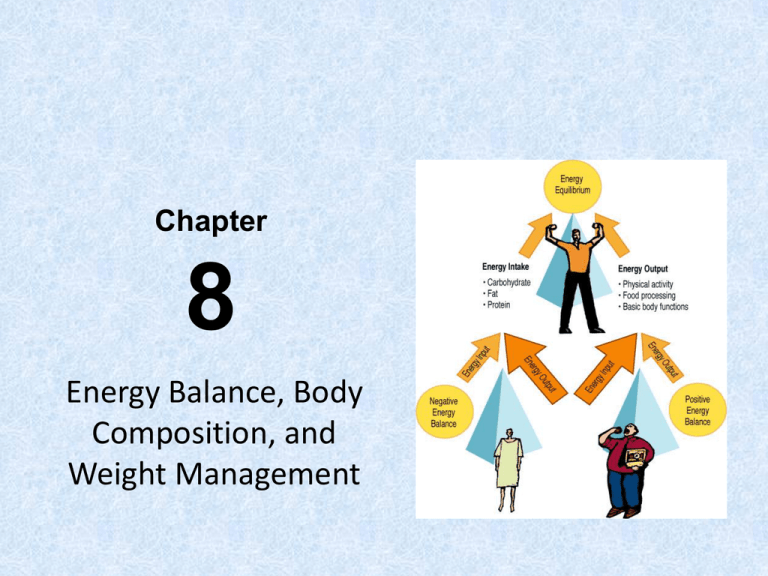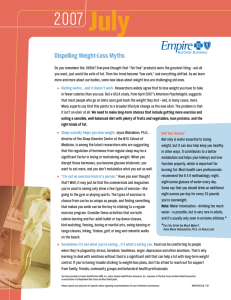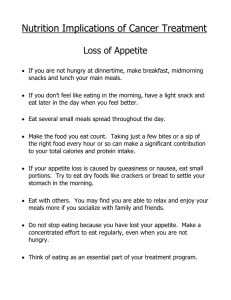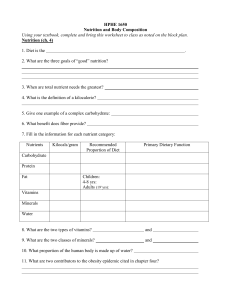Chapter 8: Energy Balance and Weight Management
advertisement

Chapter 8 Energy Balance, Body Composition, and Weight Management Energy Equilibrium • Energy Intake refers to the amount of fuel (calories) you take in through consumption of carbohydrate, protein, fat and alcohol. • Energy Output is the amount you expend – primarily for basic body functions, physical activity, and the processing of food. • Energy equilibrium is demonstrated in people who maintain a relatively constant weight. Positive Energy Balance • Positive energy balance – when you take in more energy than your body needs. – Surplus is stored as fat (long-term) and glycogen (short-term). – Pregnant women and growing children need a positive energy balance. – A positive energy balance due to overeating and inactivity leads to weight gain. Negative Energy Balance • Negative energy balance – when you take in less energy than your body needs. – Illness. – Intentional change for weight loss. – The body uses stores of glycogen and fat (protein as well with extreme deficits). Energy Equilibrium • Energy equilibrium – when the energy intake is about equal to the energy output. • Body weight change reflects overall energy balance. Energy Balance Bomb Calorimeter • We can measure the energy content of a food with a bomb calorimeter. Bomb Calorimeter • Food is completely burned inside a sealed chamber and sensors measure the amount of heat produced by combustion. • The human body does not completely digest all food and is unable to oxidize nitrogen. Therefore, we adjust the energy content downward to reflect this. Energy In • Regulation of intake – Hunger • Prompts eating; physiological desire – Satiation • Signals to stop eating – Satiety • Lack of hunger – Appetite • Psychological desire Hunger • The internal, physiological drive to find and consume food. Unlike appetite, hunger is usually experienced as a negative sensation, often manifesting as an uneasy and painful sensation. Appetite • Appetite is a psychological desire to eat that is related to the pleasant sensations often associated with food. • Appetite can trigger a desire for food, even when you are not truly hungry. • Anorexia is a decreased desire to eat food. • Polyphagia (hyperphagia) is an increased desire to eat food. Satiation / Satiety • Satiation is a feeling of satisfaction and fullness that terminates a meal. • Satiety is a feeling of satisfaction or fullness following a meal that quells the desire for food. It delays subsequent intake. Energy In: Regulatory Factors Energy Out: Fuel Uses • Major components of energy expenditure – Resting energy expenditure (REE) • Energy for basic body functions • Affected by body size, composition, age, gender – Physical activity • Highly variable • Affected by body size, fitness level, type of activity – Thermic effect of food (TEF) • Energy to digest, absorb, metabolize food Measuring Energy Expenditure • Brief history • Direct vs. indirect calorimetry • Doubly labeled water Estimating Energy Expenditure • EER: Estimated Energy Requirement – Predicts total energy expenditure (TEE) – Equations for males and females • Factors for age, weight, height, physical activity Body Composition: Understanding Fatness and Weight • Assessing body weight – Height–weight tables – Body mass index (BMI) • Weight (kg) height2 (m) • Assessing body fatness • Body fat distribution – Waist circumference Body Mass Index • What are the health risks associated with being overweight? When Energy Balance Goes Awry • Early theories of weight regulation – Fat cell theory – Set point theory • Influences on weight gain and obesity – – – – – – Heredity and genetic factors Sociocultural influences Age and lifestyle factors Gender and ethnicity Socioeconomic factors Psychological factors Weight Management • Perception of weight • Setting realistic goals • Weight-management lifestyle – Diet and eating habits • • • • Reduce total calories Reduce fat calories Increase complex carbohydrates Improve eating habits – Increase physical activity – Stress management – Self-acceptance Weight Management • Weight-management approaches – Self-help books and manuals • Watch for signs of a fad diet – Self-help groups – Commercial programs – Professional counselors – Prescription drugs – OTC drugs and dietary supplements Weight Management • Weightmanagement approaches – Surgery Underweight • Definition – BMI < 18.5 kg/m2 • Causes – Illness – Eating disorders – Metabolic factors • Weight-gain strategies – Small, frequent meals – Fluids between meals – High-calorie foods and beverages Healthy Weight Management • Healthy weight management means focusing on metabolic fitness—healthy levels of blood lipids and blood pressure—rather than on achieving a specific weight. • Permanent healthy behaviors are necessary for a long-term weight-management lifestyle. Why Do We Have Hunger Pangs? • When the stomach has been without food for at least three hours, intense stomach contractions begin, sometimes lasting two to three minutes. • Healthy young people have the strongest contractions, due to good muscle tone in the GI tract. • After 12 to 24 hours, contractions of an empty stomach can cause painful hunger pangs. Overweight and Obesity • Worldwide, the number of overweight or obese people has increased markedly in recent years. The rising rates among children are especially disturbing. • At the same time, more people are engaging in weight-control efforts and starting to do so at younger ages. Emotional Factors • Many people use food to cope with stress and negative emotions. Eating can provide a powerful distraction from loneliness, anger, boredom, anxiety, shame, sadness, and inadequacy. • To combat low moods, low energy levels, and low self-esteem, people often turn to the refrigerator. When we use food and eating to cope with our emotions, binge eating or other disturbed eating patterns can develop. Weight Cycling • Weight cycling is a pattern of losing and regaining weight, over and over again. You might expect this behavior to be harmful, perhaps harder on the body than overweight itself. • However, research shows that the potential benefits of weight loss for obese individuals outweigh the potential risks of weight cycling. Balancing Energy Sources • Balancing energy sources and controlling portion sizes can help reduce overall energy consumption. Reducing fat intake is a major step toward lowering calorie intake. Fiber-rich foods provide a feeling of fullness that can help prevent overeating. • When planning a diet, aim for a caloric intake of 20 to 35 percent fat, 10 to 35 percent protein, and 45 to 65 percent carbohydrate. The Built Environment • Our immediate surroundings influence our behaviors, and researchers have begun to link aspects of the built environment with obesity. The built environment, which can be defined as “human formed, developed, or structured areas,” includes buildings, roads, parks, and transportation systems. • People who live in neighborhoods with sidewalks and safe streets are more physically active. But when neighborhoods have low “walkability” or are considered unsafe, BMIs tend to be higher. Meal Replacements • Some people turn to meal replacements— shakes and bars, for example—to help lose weight. Meal replacements are convenient, often contain added vitamins and minerals, and reduce the choices and temptations available at mealtime. • When compared with traditional, reduced-calorie diet programs, people using meal replacements lost slightly more weight and were less likely to stop the program. Weight-Management Strategies • Books, Internet resources, and commercial programs can help some individuals lose weight. However, consumers should always proceed with caution before spending money. Drugs have potential side effects and must be used with caution and medical supervision. • For those who are extremely obese, surgical intervention is an aggressive, last-resort approach to weight management. Liposuction removes fat cells from specific parts of the body but is not considered an effective approach to weight control. ADA Position on Weight Management • It is the position of the American Dietetic Association that successful weight management to improve overall health for adults requires a lifelong commitment to healthful lifestyle behaviors emphasizing sustainable and enjoyable eating practices and daily physical activity.






